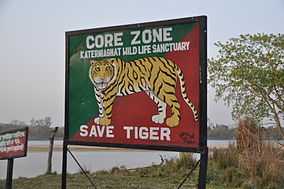Katarniaghat Wildlife Sanctuary
| Katarniaghat Wildlife Sanctuary | |
|---|---|
| Katerniaghat Wildlife Sanctuary | |
|
Signboard in Katarniaghat Wildlife Sanctuary | |
 | |
| Location | On the banks of Sarayu river Bahraich district, Uttar Pradesh, India |
| Nearest city | Lucknow (125 km) |
| Coordinates | 28°00′N 81°12′E / 28.000°N 81.200°ECoordinates: 28°00′N 81°12′E / 28.000°N 81.200°E |
| Area | 400.6 km2 |
| Established | 1975 |
The Katarniaghat Wildlife Sanctuary is a protected area in the Upper Gangetic plain in Uttar Pradesh, India and covers an area of 400.6 km2 (154.7 sq mi) in the Terai of the Bahraich district. In 1987, it was brought under the purview of the ‘Project Tiger’, and together with the Kishanpur Wildlife Sanctuary and the Dudhwa National Park it forms the Dudhwa Tiger Reserve.[1] It was established in 1975.[2]
The Katerniaghat Forest provides strategic connectivity between tiger habitats of Dudhwa and Kishanpur in India and the Bardia National Park in Nepal. Its fragile Terai ecosystem comprises a mosaic of sal and teak forests, lush grasslands, numerous swamps and wetlands. It is home to a number of endangered species including gharial, tiger, rhino, Gangetic dolphin, swamp deer, hispid hare, Bengal florican, the white-backed and long-billed vultures.
One of the best places in the world for seeing the gharial[3] in its natural habitat is the Girwa River, where it is found sympatric with the mugger. The population of gharials in this stretch was one of the three that were still breeding, when the project to conserve this reptile from the verge of extinction was initiated in 1975. However, between the years of 2001 and 2005, almost all the gharial nests were raided by tribals who consider them a delicacy.[3]
Mugger crocodiles are also seen in small number in the Girwa river,as their favorite haunts are stagnant wetlands like the many taals and baghars that dot the sanctuary. Side by side the serenely swimming gharial can be seen frolicking Ganges dolphins.
Recent discoveries in herpetofauna of Katerniaghat are highly fascinating and are represented by several species such as the banded krait, the Burmese rock python, the yellow speckled wolf-snake and the paradise flying snake. In 2012, a rare red coral kukri snake was sighted in the sanctuary.[4] This snake with the scientific name Oligodon kheriensis was first described from the North Kheri Division in 1936.[5]
See also
References
- ↑ Mathur, P. K. and N. Midha (2008). Mapping of National Parks and Wildlife Sanctuaries, Dudhwa Tiger Reserve. WII – NNRMS - MoEF Project, Final Technical Report. Wildlife Institute of India, Dehradun.
- ↑ Tripahti, K. P., Singh, B. (2009). Species diversity and vegetation structure across various strata in natural and plantation forests in Katerniaghat Wildlife Sanctuary, North India. Tropical Ecology 50(1): 191–200.
- ↑ 3.0 3.1 "Gavialis gangeticus". IUCN. Retrieved 24 September 2014.
- ↑ "Rare Indian snake species discovered at Katarniaghat sanctuary". 16 July 2012.
- ↑ Green, M. (2010). Molecular Phylogeny of the Snake Genus Oligodon (Serpentes: Colubridae), with an Annotated Checklist and Key. M. Sc. thesis, University of Toronto.
External links
- BirdLife IBA Factsheet: Katerniaghat Wildlife Sanctuary and Girijapur Barrage
- The Hindu, Mar 09, 2008: Villages in tiger habitat to be shifted by Atiq Khan
- Articles about Katarniaghat Wildlife Sanctuary - Times Of India
| ||||||||||||||||||||||||||||||||||||||||||||||
